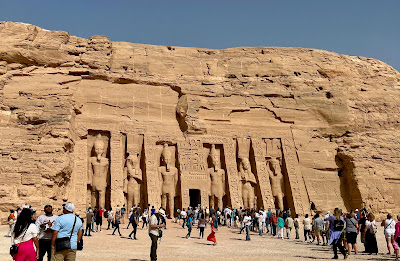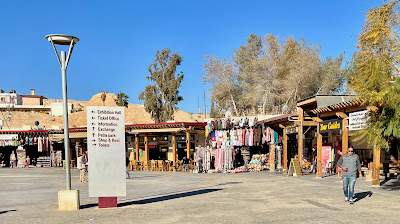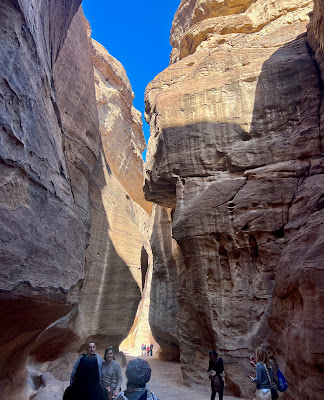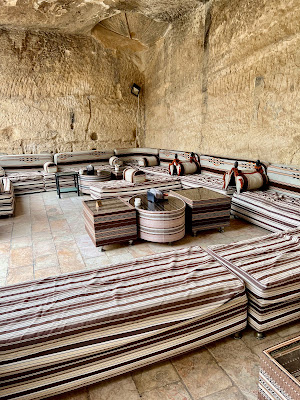The Abu Simbel Temples, located south of Aswan Egypt along Lake Nasser’s shore, are classified by many as the most famous tourist attraction in all of Egypt, after the Giza Pyramids.
 |
| The Great Temple at Abu Simbel |
Built by the greatest of the Egyptian pharaohs Ramesses II, these huge rock-cut temples marked the southern boundary of the Egyptian Empire with Nubia at the peak of its power during the New Kingdom.
Due to the construction of the Aswan High Dam and subsequent rise of the waters of the Nile River, the twin temples of Abu Simbel were under eminent threat of destruction.
On July 21, 1970 after 11 years of construction, the Aswan High Dam was completed. At a height of 364 feet, a length of 12,579 feet and a base width of 3,220 feet, the massive $1 billion dam would end the cycle of flood and drought in the Nile River region and would create enough electricity to power half of Egypt. But what about the destiny of Abu Simbel?
 | |
| Aswan High Dam power plant with the dam in the background |
An initiative was spearheaded by UNESCO, with a multi-national team of archaeologists, at a cost of over 40 million US dollars. They were to relocate the temples 210 feet above and 590 feet north west of their original site. Moving the temples would be just short of a 5 year undertaking that would include cutting the temples into 1,030 individual blocks weighing between 3 to 20 tons each and then reassembling them at their new site. The process began in early 1964 and finished in 1968. Great care was taken to orient both temples in exactly the same direction as before and a man-made mountain was erected to give the impression of the temples cut into the rock cliff. National Geographic produced a short 2-minute video. Click here to view the video.
 |
| Original location/new location map Photo: Public Domain |
 |
| Reassembling at new location |
While it was assumed that the name, `Abu Simbel' was the designation for the complex in antiquity, this is not the case. Allegedly, the Swiss explorer Johann Ludwig Burckhardt was led to the site by a boy named Abu Simbel in 1813 and the site was then named after him. Burckhardt, however, was unable to uncover the site, which was buried in sand up to the necks of the grand colossi and later mentioned this experience to his friend and fellow explorer Giovanni Batista Belzoni.
It was Belzoni who uncovered and first excavated Abu Simbel in 1817 and it is considered likely that it was he, not Burckhardt, who was led to the site by the young boy and who named the complex after him.
GREAT TEMPLE
The Great Temple at Abu Simbel took approximately twenty years to build. Also known as the Temple of Ramsses II, it was dedicated to the gods Amun-Re, Ra-Horakhty, and Ptah, as well as to the Great Pharaoh Ramesses II himself. It is generally considered the grandest and most beautiful of the temples commissioned during Ramesses II’s reign, and one of the most beautiful in all of Egypt.
 |
| L-R: Rob & Janice Loft, Jon Garth Swim, Marci Inman, Sharon Sparlin |
The Great Temple stands 98 feet high and 115 feet long with four seated colossi flanking the entrance, two to each side, depicting Ramesses II on his throne. Each status measures 65 feet in height. Beneath these giant figures are smaller statues, though larger than life-sized, depicting Ramesses' conquered enemies, the Nubians, Libyans, and Hittites.
Further statues represent his family members and various protecting gods and symbols of power. The façade of the Great Temple is decorated with hieroglyphs that commemorate the great victory of Ramsses II at the Battle of Kadesh in 1274 BC.
 |
| Statues in front of The Great Temple |
 |
| Family members next to Ramesses II |
Passing between the colossi, through the central entrance, the interior of the temple is decorated with engravings showing Ramesses and Nefertari paying homage to the gods. Ramesses' great victory at Kadesh is also depicted in detail across the north wall of the Hypostyle Hall. According to the scholars Lorna Oakes and Lucina Gahlin, these engravings are of the events surrounding the battle.
The final room, the sanctuary, remains in darkness except for two days a year. When the ancient architects rebuilt the temple they perfectly positioned it so that sunlight reaches the room on February 22, the anniversary of Ramesses accession to the throne and on his birthday, October 22. On these two dates, the sun rises and illuminates the temple corridor along with three of the four statues in the sanctuary. The first three statues are of Pharaoh Ramesses II, gods Amun-Re and Ra-Horakhty.
 |
| Looking toward the sanctuary from the main entrane |
Ramesses II was included with the gods because, like the other Pharaohs, he considered himself a god. The fourth statue remains in darkness because it represents Ptah. The fourth statue of the god Ptah, who is seated on the far left, is never illuminated at any time. Our guide said that the god Ptah was associated with the Egyptian underworld and therefore, his image is supposedly kept in perpetual darkness and hasn’t see sunlight for the past 3,200 years.
SMALL TEMPLE
The second temple, The Small Temple, is dedicated to the goddess Hathor. Although significantly smaller than the first, it was built to honor Ramesses' favorite wife, Nefertari.
 |
| The Small Temple at Abu Simbel |
The Small Temple stands at a height of 40 feet and 92 feet in length. The prestige of the queen is apparent in that, typically, a female is represented on a much smaller scale than the Pharaoh while at Abu Simbel, Nefertari is rendered the same size as Ramesses.
Queen Nefertari appears to be on an equal footing with the pharaoh although it is apparent that Ramesses II thought highly of himself. The temple is adorned by colossi across the front facade, three on either side of the doorway, depicting Ramesses and his queen Nefertari. There are four statues of the king and only two statues of the queen, each 32 feet high.
 |
| From facade of The Small Temple at Abu Simbel |
The Small Temple is also notable in that it is the second time in ancient Egyptian history that a ruler dedicated a temple to his wife, the first time being the Pharaoh Akhenaton, 1353-1336 BCE, who dedicated a temple to his queen Nefertiti.
 |
| Inside The Small Temple |
 |
| Looking toward the sanctuary from the main entrance |
 |
| Inside The Small Temple |
GETTING TO ABU SIMBEL
The Abu Simbel temples are located a 3-4 hour drive south of Aswan, but most tourists actually arrive at Abu Simbel by plane. The flight from Aswan is only 30 minutes and there are two flights a day, timed so that tourists will have about two hours to spend at the temples.
It is also possible to visit Abu Simbel by joining a Lake Nasser cruise. These ships moor just in front of the temples so that passengers have a chance to see the temples by moonlight and in the early morning light.
Our ship, the Chateau Lafayette, docked in Aswan and we made a day trip to Abu Simbel by bus. The 4-hour drive was bleak and barren for the most part but was so worth it. This is a true engineering marvel and not to be missed.
 |
| Facing the temples from the Sound & Light Show seating area |
 |
| View of Lake Nasser |



























































